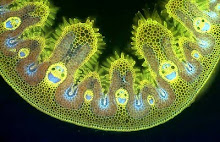It came as a surprise to me that red-hot pokers thrive in my garden here in North East England. If you look at the distribution map of the species, through Africa and Madagascar, with an outlier in Yemen, you'd imagine that heat and dry conditions are a requirement but when you look at the habitats occupied by many of the species - cooler, higher altitude sites - maybe it's not so surprising that they do well in my flower borders. This summer, which was cool and wet, seems to have suited them pretty well......
.... especially this yellow-green flowered variety. I've lost its label but I think it might be 'Percy's Pride'. This plant produced 15 flower spikes and was in bloom for six weeks.
The best display of Kniphofia uvaria that I've ever see in Britain is this one, in the sand dunes on the Northumberland coast at Low Newton-by-the-sea where it is verging on becoming invasive They're not the conditions that would be easy to replicate in most gardens though.
I'm always interested in the native insects that visit exotic flowers in British gardens. In its native habitats Kniphofia is pollinated by sunbirds and each individual flower produces a large volume of nectar to attract these energetic pollinators. The nectar must trickle down those long, downward-pointing tubular flowers, because peacock butterflies seem to have no trouble in reaching it.
Access is more of a struggle for wasps, which will do almost anything to reach sweet nectar in autumn when they are no longer feeding their brood. This enterprising individual discovered that the easiest way to reach a reward was to chew a hole through the corolla ......
...... while this one chose to do it the hard way, forcing its way into a flower that really evolved to accommodate a sunbird's long, slender, curved beak.































































